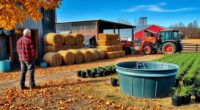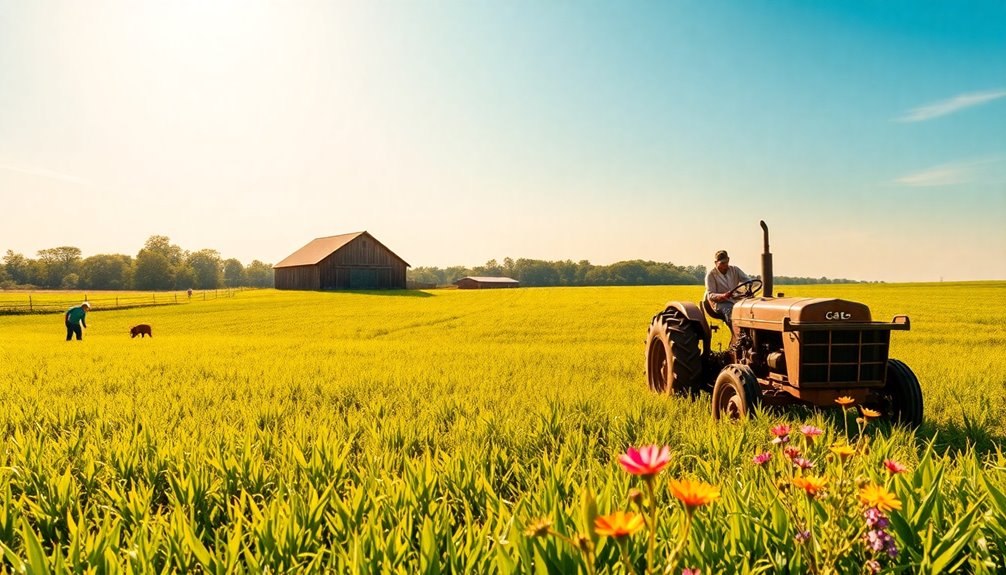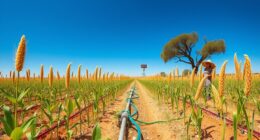When evaluating lease options for extra winter pasture, consider your herd’s grazing needs, land quality, and location. Review lease terms carefully, focusing on duration, costs, and accessibility. evaluate land suitability by checking soil, fencing, and water access, and guarantee the site is manageable during winter conditions. Don’t forget to compare legal agreements and seasonal factors that could impact your operation. If you want to make the best choice, exploring these factors will give you a clearer path forward.
Key Takeaways
- Review lease terms, duration, renewal options, and restrictions to ensure flexibility in winter grazing schedules.
- Assess land quality, water access, and infrastructure, including roads and fencing, for winter management suitability.
- Evaluate surrounding land use and environmental factors impacting livestock safety and compliance during winter.
- Consider lease costs, including payments, maintenance, and potential upgrades, for budget planning and sustainability.
- Confirm legal agreements, access rights, and dispute resolution clauses to prevent conflicts and ensure smooth operations.
Assessing Your Herd’s Grazing Needs
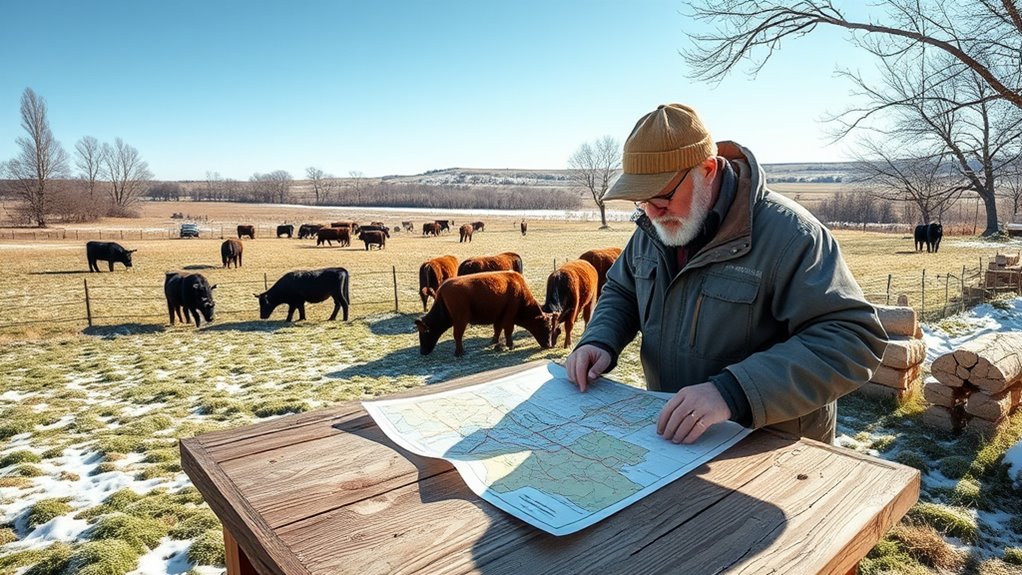
Understanding your herd’s grazing needs is essential for maintaining their health and optimizing pasture use during winter. You need to evaluate how many animals you’re managing and their nutritional requirements, especially when forage quality declines. Properly appraising herd health helps determine if they require supplemental feed or specific grazing strategies. Implementing a pasture rotation plan ensures your land isn’t overgrazed and keeps forage available throughout winter. By carefully monitoring the herd’s intake and pasture condition, you can prevent issues like nutrient deficiency or trampling damage. Regular pasture assessment is crucial for adjusting grazing plans and ensuring sustainable land use. This assessment allows you to match your herd’s needs with available land, reducing the risk of overburdening pastures and promoting overall herd health. A strategic approach to grazing needs is key to sustainable winter management, and incorporating essential oils for herd health can support overall well-being during this season.
Exploring Different Lease Types
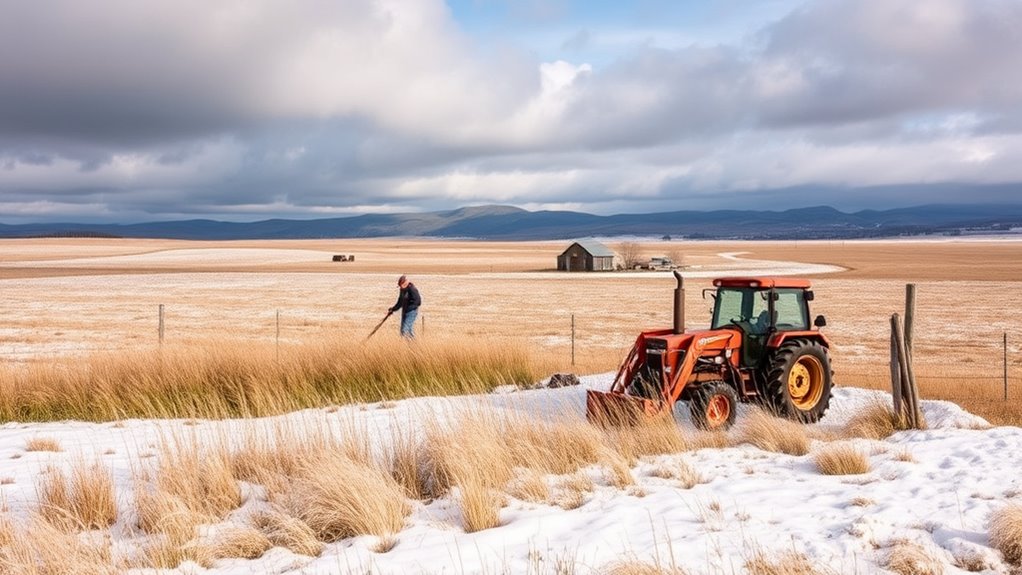
When considering lease arrangements for winter pasture, it’s important to recognize the variety of options available to best suit your herd’s needs and your land management goals. Different lease types, such as fixed-term leases or seasonal agreements, offer flexibility depending on your grazing strategy. If you plan to implement pasture rotation, a flexible lease can allow you to adjust grazing periods and land use. Some leases may include options for lease renewal, giving you the security to manage your herd over multiple seasons. Understanding these options helps you choose a lease structure that supports sustainable land use while maintaining grazing consistency. Carefully reviewing lease terms ensures you maximize land productivity and minimize disruptions to your herd’s winter grazing plan. Additionally, considering Cost and Budgeting aspects can help you evaluate the affordability and financial sustainability of different lease options. Being aware of legal considerations in lease agreements can prevent future disputes and ensure compliance with land use regulations. Incorporating the type of lease agreement into your planning can further optimize land utilization and grazing flexibility.
Determining Budget and Cost Factors
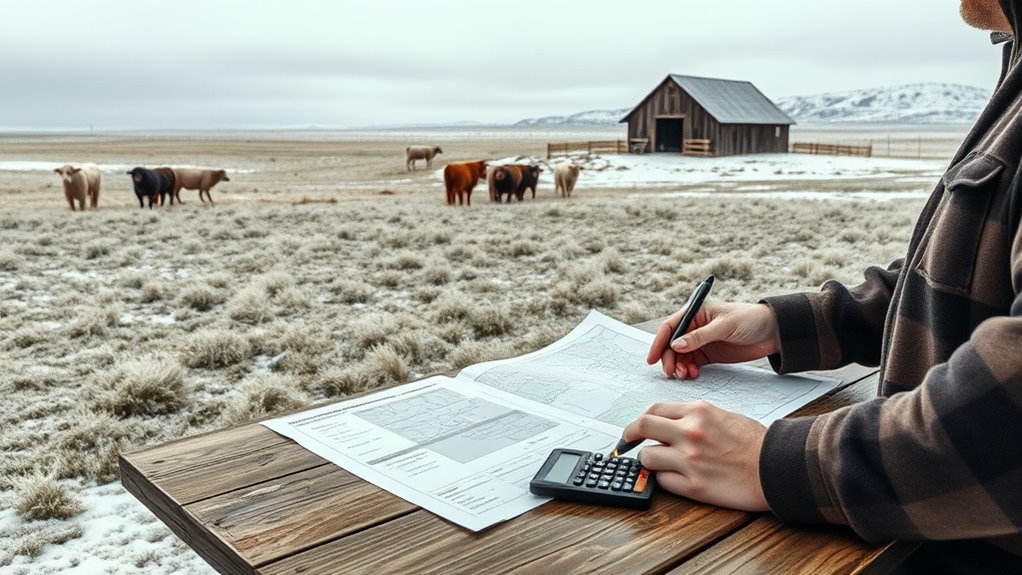
Establishing a clear budget is essential before entering into a winter pasture lease, as it helps you identify what costs are manageable and what expenses might arise. Start with a thorough cost analysis to understand all potential expenses, including lease payments, maintenance, fencing, and water access. Good budget planning guarantees you allocate funds appropriately and avoid surprises during the season. Consider seasonal fluctuations in costs, such as increased feed or labor. Be realistic about your financial limits and prioritize essential expenses. Additionally, reviewing cost factors associated with leasing land can provide valuable insights into budgeting effectively. For example, understanding the size and features of the pasture can influence maintenance and fencing costs. Incorporating diversification strategies in your financial planning can help mitigate unexpected expenses and ensure stability. Analyzing site-specific conditions can further refine your budget estimates. Being aware of market trends and how they impact land prices can also aid in making informed leasing decisions. By clearly outlining your budget, you can compare lease options effectively, ensuring the pasture fits your financial capacity. This proactive approach minimizes risk and helps you make informed decisions for a successful winter grazing strategy.
Selecting Prime Location and Accessibility
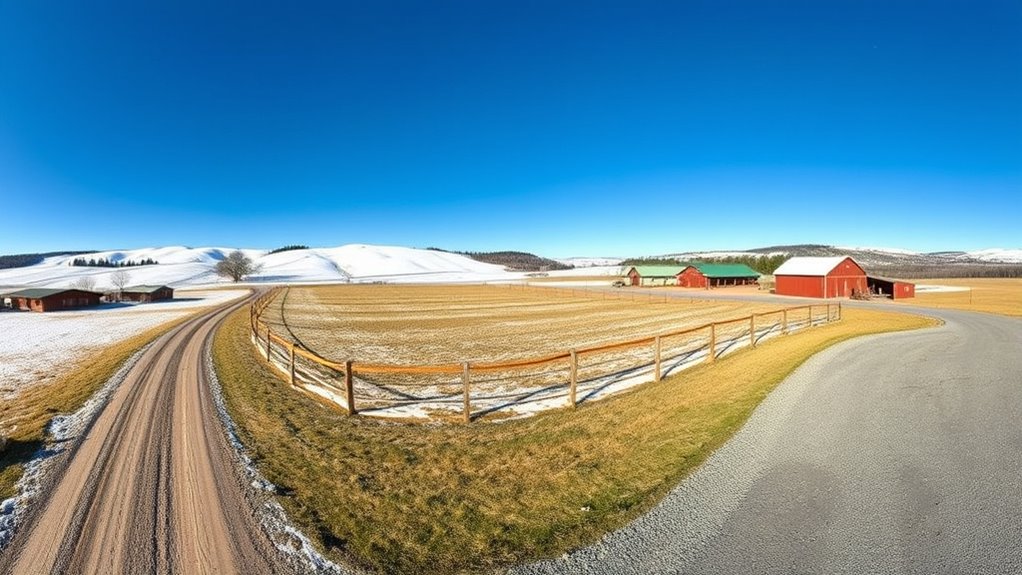
Choosing a location close to your farmstead makes daily management easier and saves time. Make sure access roads are well-maintained for smooth transportation, especially in winter. Also, consider how the surrounding land is used, as nearby activities can impact pasture safety and availability. Ensuring compliance with fire safety regulations when selecting and preparing the site can further protect both livestock and property. Additionally, evaluating the Glycolic Acid benefits for skin of the area can help in assessing its suitability for livestock health and safety. Being aware of privacy policies and data practices related to property management tools can help safeguard your farm’s information. Incorporating crochet styles for locs in your farmstead’s aesthetic might also create a more welcoming environment for visitors and staff. Properly assessing pasture management techniques can optimize grazing and improve pasture productivity within your chosen site.
Proximity to Farmstead
Why is proximity to your farmstead so essential when selecting winter pasture? Being close reduces travel time, making fence maintenance easier and less time-consuming. It also allows you to implement efficient grazing rotation, ensuring livestock don’t overgraze any one area and stay healthy during winter months. When pasture is nearby, checking on animals becomes simpler, helping you spot issues early. Additionally, close proximity minimizes stress on your livestock, as they spend less time traveling and more time grazing. This convenience helps you manage resources more effectively and keeps your operation running smoothly. Regularly inspecting stored resources and understanding signs of spoilage can also help maintain healthy livestock and reduce waste. Furthermore, choosing nearby pasture can enhance your ability to monitor animal health, leading to better overall herd management. Being aware of environmental conditions and how they impact pasture quality is crucial for planning winter grazing and ensuring your animals’ resilience. Additionally, proximity allows for more frequent resource assessments, helping you adapt quickly to changing conditions and maintain optimal pasture health. Staying informed about shelter needs and environmental conditions is crucial to ensure your livestock remain comfortable and resilient during winter.
Ease of Access Roads
Accessible roads are vital when selecting winter pasture because they directly influence how easily you can reach and manage your livestock. Well-maintained access roads ensure safe, reliable winter access routes, reducing the risk of getting stranded or damaging equipment. When evaluating lease options, consider the condition of existing access roads and how often they require maintenance. Good access routes allow for efficient hauling feed, equipment, and livestock, especially during snowstorms or icy conditions. Look for roads that are wide enough for trucks and emergency vehicles and check if snow removal is feasible. Proper access road maintenance is essential for year-round usability, ensuring you can respond quickly to livestock needs and prevent delays caused by impassable routes. Additionally, inspecting the road condition and maintenance history can help determine the overall reliability of the winter pasture access. Regular upkeep and snow removal capabilities further enhance the accessibility and safety of these routes during harsh winter months. Maintaining clear and accessible roads also minimizes the need for emergency interventions, providing peace of mind during critical winter periods.
Surrounding Land Use
Evaluating the surrounding land use is essential when selecting a prime winter pasture location, as it directly impacts accessibility and operational efficiency. Consider whether the land supports wildlife conservation efforts, which can influence land management practices and future lease terms. Check for neighboring land restrictions that might limit your activities or impose regulations on livestock movement. Avoid areas with conflicting land uses, such as residential zones or commercial developments, which could lead to noise complaints or access issues. Look for a location with minimal disturbance from nearby industries or recreational areas. Ensuring the land’s use aligns with your operational needs helps maintain smooth winter pasture management, reduces conflicts, and supports sustainable land stewardship.
Understanding Lease Terms and Duration
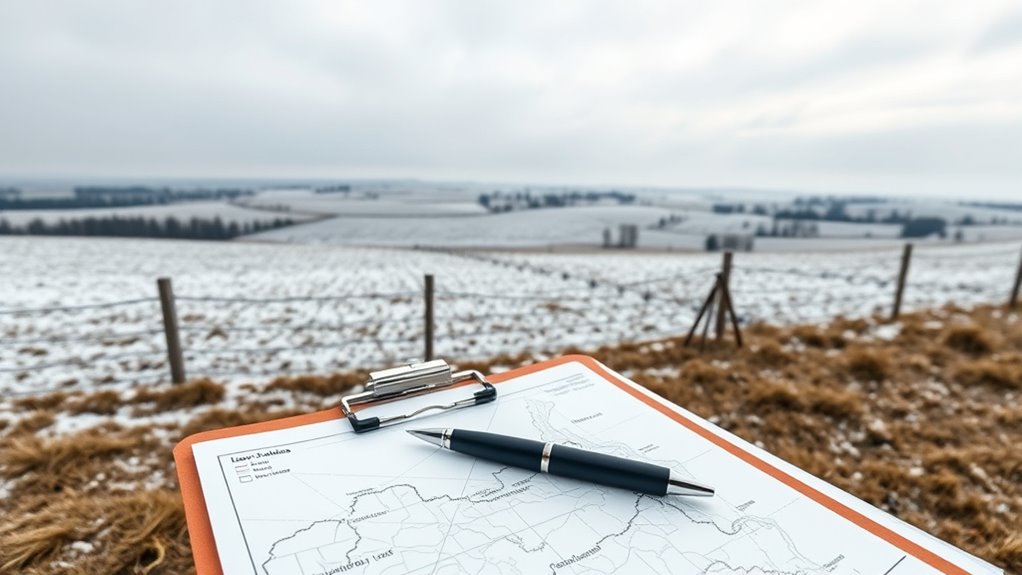
Understanding lease terms and duration is essential to guarantee your winter pasture arrangement meets your needs and minimizes surprises. You should carefully review the lease agreement to know how long it lasts and what conditions apply. Pay attention to clauses about lease renewal, which allow you to extend the agreement if needed. Knowing the renewal process helps you plan ahead and avoid last-minute disruptions. Additionally, understand the conditions for lease termination, including notice periods and penalties. This knowledge ensures you’re prepared if circumstances change or if you need to end the lease early. Clear understanding of these terms helps you manage your pasture efficiently, avoid misunderstandings, and secure your grazing plan throughout the winter season.
Evaluating Land Quality and Suitability
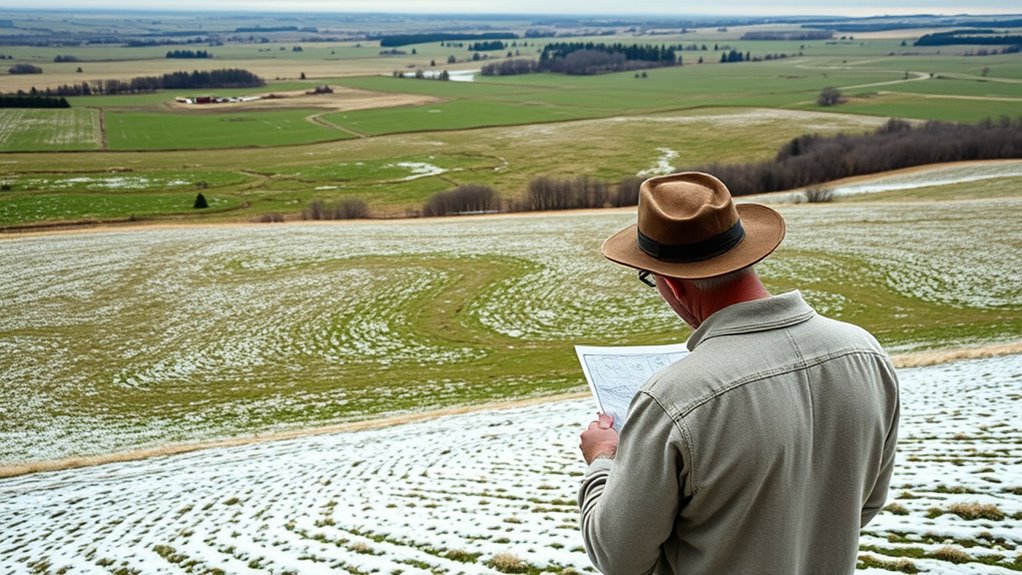
When evaluating land for winter pasture, you need to check its soil fertility and composition to guarantee it can support your livestock. Accessibility and infrastructure are also critical; consider how easily you can reach the land and whether it has the necessary facilities. These factors help determine if the land is suitable and will meet your needs during the colder months.
Soil Fertility and Composition
Evaluating soil fertility and composition is essential for determining whether winter pasture land is suitable for grazing. You should test soil pH to guarantee it falls within the optimal range for your forage crops, typically around 6.0 to 7.0. Soil pH affects nutrient availability and plant growth, so maintaining proper levels is crucial. Additionally, assess the organic matter content, which influences soil structure, moisture retention, and fertility. High organic matter indicates healthy soil capable of supporting lush pasture growth, while low levels may require amendments. Conducting soil tests provides vital data to decide if the land needs lime, fertilizers, or organic amendments. Ensuring the soil’s fertility and composition aligns with your grazing needs helps maximize pasture productivity and sustainability throughout the winter months.
Accessibility and Infrastructure
Evaluating land quality and suitability involves inspecting how accessible and well-developed the property is for winter grazing. First, assess the fence quality; sturdy, well-maintained fences ensure your livestock stays safe and secure throughout the season. Poor fencing can lead to escapes and added stress. Next, check water access—reliable, clean water sources are essential for animal health and productivity. Confirm the availability and proximity of water points, such as streams, ponds, or troughs, and ensure they won’t freeze in winter. Consider the terrain’s accessibility for equipment and personnel, making sure roads or pathways are in good condition for hauling feed or moving livestock. Proper infrastructure minimizes logistical challenges and supports effective, safe grazing during the cold months.
Reviewing Legal and Contractual Aspects
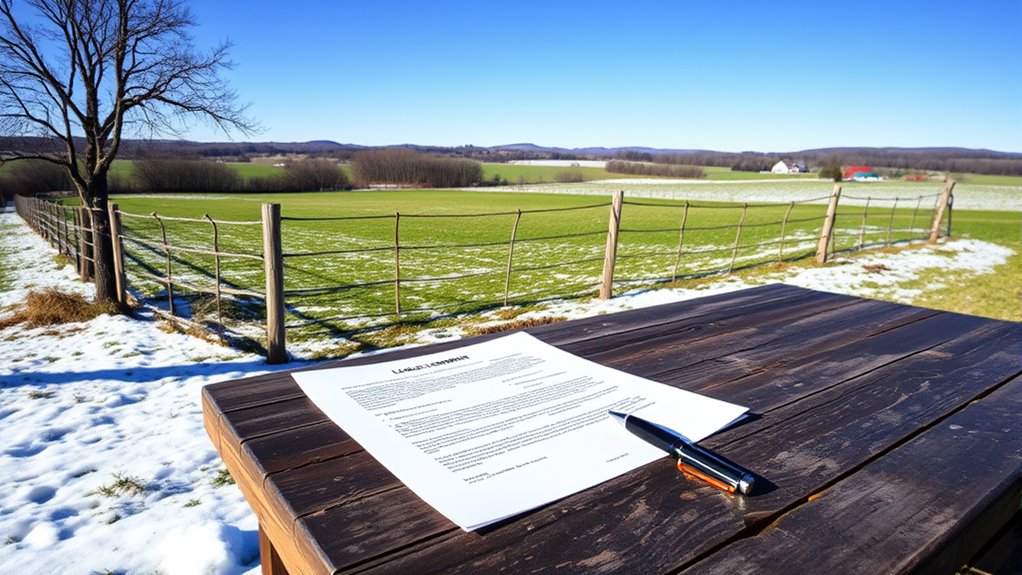
Understanding the legal and contractual aspects of lease options is crucial to safeguard your interests and guarantee clear expectations. You need to carefully review the lease agreement to confirm it clearly states the terms, duration, and payment schedules. Pay close attention to legal obligations both you and the landowner must fulfill, such as maintenance responsibilities and usage restrictions. Clarify any clauses related to renewal, termination, and dispute resolution to prevent misunderstandings later. It’s wise to consult a legal professional to verify that the agreement complies with local laws and adequately protects your rights. By thoroughly reviewing these aspects, you can avoid potential conflicts, ensure smooth access to winter pasture, and make informed decisions that align with your operational goals.
Considering Seasonal and Environmental Factors
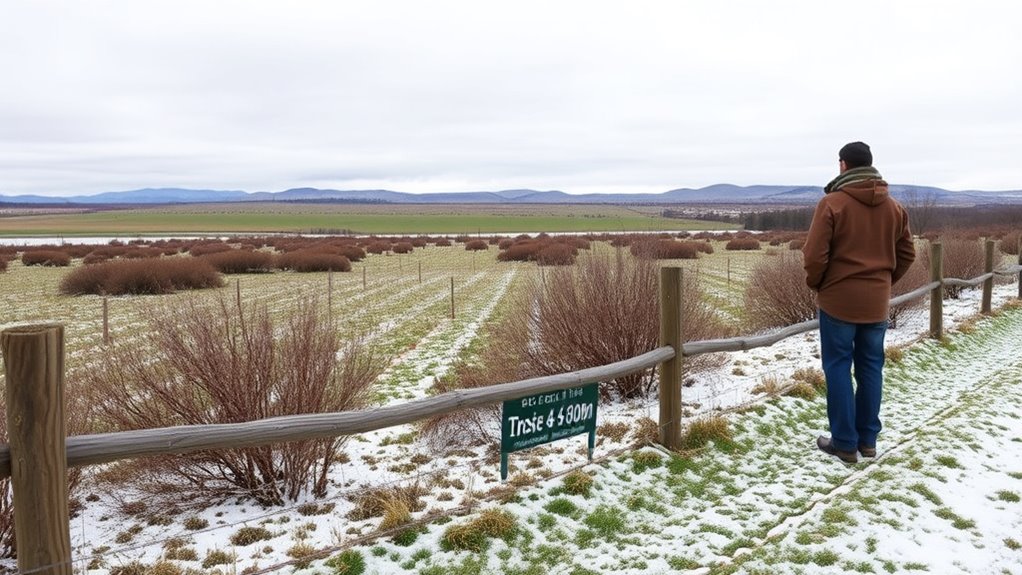
Considering seasonal and environmental factors is essential when selecting a winter pasture lease, as these elements directly impact forage availability and land management. Climate considerations, such as temperature fluctuations and winter precipitation, determine how well the land supports seasonal vegetation growth. Understanding local climate patterns helps you anticipate forage quality and quantity throughout the season. Additionally, assess how the land’s environment responds to winter conditions—frozen ground, snow cover, and drainage—all influence grazing practicality. Seasonal vegetation varies with climate and affects the nutritional value of forage. By evaluating these factors, you can choose a lease that aligns with your livestock’s needs and minimizes risks related to harsh weather or poor forage availability. This proactive approach ensures a more successful winter grazing strategy.
Making the Final Decision and Negotiating Terms

After evaluating the seasonal and environmental factors, it’s time to make your final decision and begin negotiating the lease terms. Focus on clear communication during lease negotiation to guarantee both parties agree on essential contractual terms. Review the lease agreement carefully, paying attention to duration, rent, renewal options, and any restrictions or responsibilities. Don’t hesitate to ask questions or suggest modifications that protect your interests. Confirm that the contractual terms align with your farming schedule and pasture needs. Be prepared to negotiate points like access rights, maintenance responsibilities, and dispute resolution. Once you reach an agreement, get everything in writing. A well-negotiated lease with clear contractual terms helps prevent misunderstandings and sets a solid foundation for a successful winter pasture arrangement.
Frequently Asked Questions
How Do Lease Options Impact Long-Term Pasture Management Strategies?
Lease options influence your long-term pasture management by affecting lease duration and grazing flexibility. Short-term leases might limit your ability to plan for future grazing needs, while longer leases offer stability and consistent access. Carefully consider how lease terms align with your rotational grazing schedules and pasture regeneration goals. By choosing the right lease, you can optimize pasture use, guarantee sustainable growth, and maintain effective management strategies over time.
What Are Common Pitfalls When Negotiating Lease Agreements for Winter Pasture?
Think of negotiating a winter pasture lease as steering a delicate dance. Common pitfalls include lease miscommunication, where unclear language causes misunderstandings, and payment disputes, which can strain relationships. You might overlook specific terms or assume mutual understanding, leading to friction later. To avoid these pitfalls, clarify all details upfront, document agreements thoroughly, and keep communication open. This guarantees you maintain harmony and avoid stepping on each other’s toes during winter grazing.
How Does Lease Duration Influence Seasonal Grazing Flexibility?
Lease duration directly impacts your seasonal grazing flexibility. A longer lease might restrict your ability to adapt to changing conditions or seek lease renewal if circumstances change. Shorter leases offer more flexibility to adjust grazing permits or switch pastures as needed, but they can also mean more frequent negotiations. Carefully consider how the lease term aligns with your grazing plans to ensure you maintain the flexibility you need throughout the season.
Are There Tax Benefits Associated With Leasing Additional Winter Pasture?
You might be surprised to learn that leasing additional winter pasture can offer tax benefits. Many farmers find that lease payments qualify for tax deductions, reducing taxable income. These income offsets can improve your financial outlook by lowering your overall tax bill. To maximize benefits, keep detailed records of lease costs, and consult with a tax professional to guarantee you’re taking full advantage of any available deductions related to your leased pasture.
How Can I Assess the Landowner’S Experience With Winter Grazing?
To assess the landowner’s experience with winter grazing, start by reviewing their landowner credentials and ask about their grazing history. You should inquire how long they’ve managed winter pastures and if they’ve dealt with challenges like snow or cold weather. Talk to other tenants or neighbors to gather firsthand feedback. This helps you determine if they’re knowledgeable and reliable, ensuring your livestock’s winter grazing needs are well-managed.
Conclusion
When choosing winter pasture leases, remember that “a stitch in time saves nine.” Carefully evaluate your herd’s needs, land quality, and lease terms to make an informed decision. Don’t rush the process—taking the time to negotiate favorable terms and understand environmental factors will pay off in the long run. With thorough planning and patience, you’ll guarantee your herd stays healthy and well-fed all winter.


